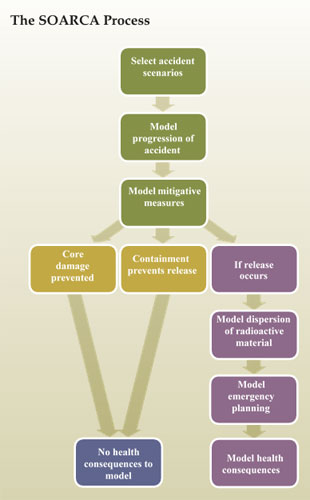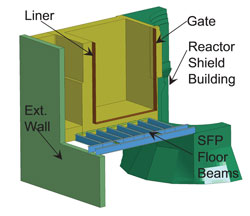Backgrounder on Computer Modeling of Severe Accidents
Printable Version
On this page:
Background
The NRC and its predecessor, the Atomic Energy Commission, have consistently applied analytical tools to the issue of how severe events at U.S. commercial nuclear power plants might affect nearby populations and the environment. These analyses help the agency and the companies operating nuclear reactors remain prepared to prevent accidents, react to them if they occur and keep the public safe. Early analyses, such as the AEC's Reactor Safety Study, which the NRC completed in 1975 as the "WASH-1400" report, aimed for estimates "as realistic as is reasonably attainable." In the time since that report, advances in computer modeling and the accumulation of experimental and operational data have greatly improved the realism of current analyses.
Two state-of-the-art computer codes, incorporating decades of research into severe reactor accidents, have proven particularly useful in analyzing potential accidents. The first code, MELCOR, examines how an accident progresses, and how safety systems and actions by a plant's staff might reduce an accident's severity or even prevent it. If the analysis indicates radioactive material would leave the reactor core, the code also examines where that material might end up, either within various systems and structures or released into the environment. The second code, MACCS, uses the MELCOR results of radioactive material reaching the environment to estimate potential public health effects and other types of consequences. Both codes have been reviewed by experts in several related fields to help validate their effectiveness.

State-of-the-Art Reactor Consequence Analyses

The NRC began the State-of-the-Art Reactor Consequence Analyses project in 2007 to continue the process of enhancing the realism of estimates for public health consequences in the unlikely event of a nuclear power plant accident. SOARCA analyzed several scenarios, including an earthquake-caused loss of electrical power, a so-called "station blackout," at two plants: the Surry Power Station, with pressurized-water reactors near Surry, Va.; and the Peach Bottom Atomic Power Station, with boiling-water reactors near Delta, Pa. The project combined up-to-date information about the plants with local population data and emergency preparedness plans. The staff used both MELCOR and MACCS to consider how the scenarios might affect the public.
The NRC staff published SOARCA's initial results in November 2012, including appendices to address public comments and an independent external peer review committee's input, as well as a limited comparison of the March 2011 Fukushima Daiichi nuclear accident with the SOARCA results. The agency published additional results in 2016, analyzing uncertainties for Peach Bottom, and in 2019, examining a different pressurized-water reactor design at the Sequoyah Nuclear Plant near Soddy-Daisy, Tenn. The Peach Bottom uncertainty report and Sequoyah report examined hundreds of variations on the main analysis to address the uncertainties involved in such a complex scenario.
SOARCA's main findings fall into three basic areas: how a reactor accident progresses; how existing systems and emergency measures can affect an accident's outcome; and how an accident would affect the public's health. The findings include:
| • |
Existing resources and procedures can stop an accident, slow it down or reduce its impact before it can affect public health; |
| • |
Even if accidents proceed uncontrolled, they take much longer to happen and release much less radioactive material during the analyzed event than some earlier reports suggested; and |
| • |
The analyzed accidents would cause essentially zero immediate deaths and only a very, very small increase in the risk of long-term cancer deaths. |

Spent Fuel Pool Study

All nuclear power plants store used or "spent" reactor fuel in deep pools of water built into the plants. The pools' robust concrete structure and stainless steel liner (shown in light green at right for a boiling-water reactor computer model) keep more than 20 feet of water above the fuel, both for cooling and to provide radiation shielding for plant workers. The March 2011 Fukushima accident raised questions about spent fuel pool safety and whether the NRC should require U.S. nuclear power plants to transfer spent fuel more quickly from pools to dry cask storage containers. The NRC undertook a study, completed in 2013, to improve our understanding of the risks and consequences of potential spent fuel pool accidents.
This study evaluated whether a severe, though unlikely, earthquake would damage the pool enough to cause a leak. The earthquake considered was stronger than what could be reasonably expected at the analyzed plant site, and in fact was likely more challenging for the spent fuel pool structure than the stresses experienced at the Fukushima Daiichi pools. Computer modeling showed a very high likelihood the pool would survive intact after such a severe quake. The study then accounted for the possibility of a leak by analyzing where the leak would be expected, the size of the leak, and whether the spent fuel could overheat and potentially release radioactive material into the environment. In order to estimate the hypothetical consequences, the staff analyzed scenarios where some preplanned and improvised emergency response actions were either unsuccessful or could not be carried out. Finally, the staff analyzed what the public health and environmental effects of a radiological release would be in the area surrounding the plant.
The study concluded that, apart from a few weeks immediately after fuel is moved to the pool from the reactor, the plant would have several days to restore fuel cooling and prevent fuel damage. The study concluded that the analyzed severe earthquake had about a one time in 10 million years chance of releasing radioactive material into the environment. The study concluded the effects of a spent fuel pool accident are similar or smaller than suggested by earlier analyses, and that the potential public health effects remain very, very low. The report reinforces the NRC's conclusion that spent fuel pools protect public health and safety.
March 2020

Page Last Reviewed/Updated Tuesday, May 12, 2020